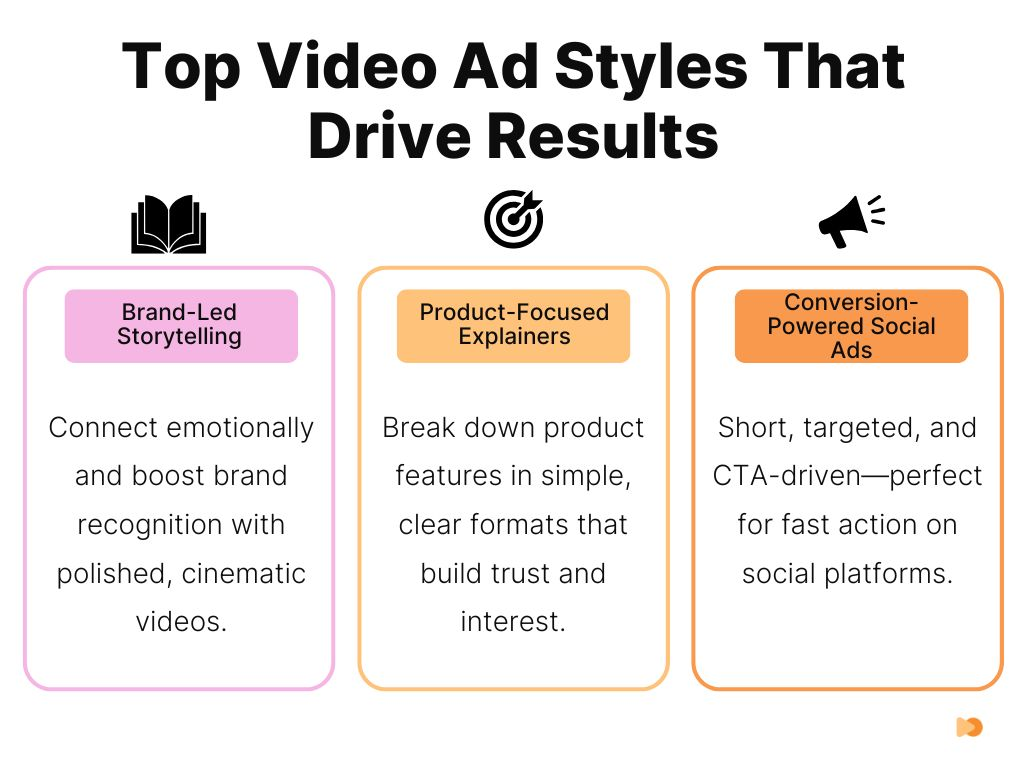Imagine scrolling through your social media feed when a captivating video ad catches your eye. It’s clever and engaging, leaving you wanting to know more about the product. This is the power of video advertising—a vital tool for brands to connect with audiences effectively.
The explosion of short-form videos across social media platforms has created both opportunity and confusion for marketers. With so many types of video advertising available, how do you know which will deliver the best results for your campaign objectives?
At Vidico, we’ve produced over 1,200 video campaigns for brands like TikTok, Square, and Spotify. Our data shows that strategic selection of video ad types can increase engagement by up to 300% compared to randomly selected formats.
In this article, we’ll explain the various types of video advertising, helping you launch campaigns that engage and deliver substantial results for your brand.
Key Takeaways
- Video ads capture 2-3x more attention than static content across all platforms
- The right video format depends on your specific marketing goals and funnel position
- Brand-led storytelling builds emotional connection while product-focused content drives consideration
- Our systems approach yields up to 10x more video assets from a single production
- Most brands waste 40% of their video budget by treating each video as a separate project
Content
Top 10 Video Advertising Types & Examples
1. Brand Commercial
Brand videos are designed to amplify brand identity and resonate emotionally with viewers. These commercials are more than just advertisements; they reflect a brand’s ethos and aspirations, designed to resonate on a deeper level.
Brand videos often leverage high-quality production, compelling narratives, and a strong call to action to boost brand recognition and loyalty.
Key Features:
- High production value
- Emotionally engaging storytelling
- Broad audience appeal
- Strong brand messaging
- Strategic placement on television and premium digital channels
Kickstart your video ad journey with Vidico [1]! Schedule a free 30-minute strategy session today, where we’ll collaborate to create videos that meet your needs.
2. Case Study Videos
Case study videos showcase real-world applications of a product or service and highlight customer success stories for older and younger audiences.
Focusing on customer successes validates the product’s value, builds trust, and engages potential customers. Video marketing is an effective way to demonstrate a brand’s offerings’ practical benefits and effectiveness.
Key Features:
- Real customer experiences
- Demonstrates product or service effectiveness
- Builds trust and credibility
- Often includes measurable results.
- Utilizes interviews and narrative storytelling
3. Culture
Culture videos provide a behind-the-scenes look at a company’s environment and core values. These are essential for humanizing a brand and attracting customers and potential employees by showcasing the company’s personality, interviewing company thought leaders, and describing their work environment.
These promotional videos highlight office events, day-to-day operations, employee interviews, and community activities, emphasizing the company’s commitment to its values and people.
Key Features:
- Highlights company values
- Shows behind-the-scenes company life
- Engages current and prospective employees
- Boosts brand authenticity
- Often informal and fun
4. Customer Testimonials
Customer testimonials are video endorsements from existing customers satisfied with your product or service. They are highly effective in building trust and influencing potential buyers by showing real-life examples of customer satisfaction.
Customer video ads typically feature various customers speaking candidly about their experiences, focusing on how the product has improved their lives or businesses.
Key Features:
- Features real customer opinions
- Enhances credibility
- Personal stories of customer base experiences
- Can address potential concerns of potential customers
- Typically straightforward and genuine
Direct response social media videos are crafted to elicit immediate action from viewers, such as making a purchase or signing up for more information. These ads are highly targeted and results-driven, with clear calls to action for potential customers.
Key Features:
- Strong, clear call to action
- Targeted content
- Short and engaging
- Measurable outcomes
- Optimized for social media platforms
Toggl increased conversion rates by 32% and reduced cost-per-acquisition by 27% using our video system for their product launch campaign → See our work
6. Educational
Educational videos aim to inform and enlighten the audience about a particular topic related to the brand’s industry through a thought leader or expert.
These marketing videos are valuable for building brand authority, helping viewers and potential customers make informed decisions, and gaining more insight than other advertisers.
Key Features:
- Informative and instructional
- Builds thought leadership
- Covers industry-relevant topics
- Often uses clear, concise explanations.
- Suitable for long-term content strategy
7. Explainer Videos
Explainer videos are short, engaging pieces that break down complex ideas into simple, easy-to-understand formats.
A live-action recording or multiple animated videos are perfect for introducing new products or services and explaining how they work.
Key Features:
- Explainer video can simplify complex concepts.
- Animated or live video ad formats
- Typically, under 3 minutes
- Focuses on solving a problem
- High shareability on digital platforms
8. How-To
How-to videos guide the viewer through a process, teaching them how to use a product or perform a specific task. These practical, step-by-step, creative videos help reduce customer service queries and increase user satisfaction.
Key Features:
- Step-by-step instructions
- Enhances user experience
- Reduces support calls
- Demonstrates product usage
- It often includes tips and best practices.
Want to master your creative brief process? Get our Creative Brief Template to streamline your next project.
9. Mini-Doc
Mini-docs are short documentaries that tell a story or explore a topic in-depth, offering a more substantial narrative experience. They are great for creating emotional connections and deeper engagement with the audience and target customers.
Key Features:
- Narrative storytelling
- In-depth exploration of a subject
- Emotional customer engagement
- Longer video ad format than the typical
- It offers a cinematic feel.
10. Product Spotlight
Product spotlight videos focus exclusively on showcasing products- their features and benefits. These creative videos are crafted to highlight product uniqueness and drive sales by demonstrating value and functionality.
Key Features:
- Detailed product demonstrations
- Highlights unique features
- Directly addresses how it solves user problems.
- Visually engaging
- Can include user guides or tutorials
8 Types of Video Ad Formats
1. Pre-roll Video Ads
Pre-roll ads appear before the main content begins. They are designed to capture the viewer’s attention, making them a popular choice for delivering impactful messages quickly, as viewers are less likely to skip them.
2. Mid-roll Video Ads
Mid-roll ads are placed within the main video content, similar to a commercial break on television. These are effective for longer content, as they capture viewers already engaged with the video, providing a natural break in viewing.
3. Post-roll Video Ads
Positioned at the end of the marketing video, post-roll ads target viewers who have watched the video to completion, suggesting a high level of interest in the subject matter. These ads can be effective for strong calls to action or reinforcing brand messages.
Get your free video marketing plan tailored to your funnel and business goals.
4. Instream Video Ads
Instream ads are integrated directly into the streaming video and can be pre-, mid-, or post-roll. In-feed video ads are designed to blend with the main content, providing a seamless viewing experience.
5. Outstream Video Ads
These ads are not tied to any content and can appear anywhere on a webpage, often popping up between paragraphs of text or in sidebars. Outstream ads expand to play in a large format, grabbing attention irrespective of video content.
6. Interactive Video Ads
Interactive ads allow viewers to engage directly with the content through interactive elements like clickable areas or quizzes. These ads are highly engaging and can significantly increase viewer interaction and retention.
7. Overlay Ads
Overlay ads appear on top of video content, usually at the bottom, and can be either text or images. These ads are less intrusive and allow viewers to continue watching the content while delivering an advertising message.
8. Non-Overlay Ads
Contrasting with overlay ads, non-overlay ads do not share screen space with video content. Instead, they occupy exclusive screen real estate, ensuring the viewer’s attention is undivided during playback, typically seen before or after the main content.
What’s the Purpose of Video Ads?
Video ads serve a multifaceted purpose, effectively utilizing visual storytelling to enhance sales volumes and generate excitement around products or services. They create a buzz around products or services, efficiently conveying information in a manner that is both concise and captivating to the audience and new talent.
Video ads can break down complex messages into digestible content that captures the audience’s attention. Moreover, the video’s visual and auditory nature allows brands to expand their reach, connecting with a broader audience across various platforms and mobile devices.
Are you new to video marketing? No problem! Sign up for our complimentary consultation, and we’ll share our expertise to get you up to speed. Let’s create video ads to captivate your audience, amplify your brand message, and drive measurable results.
Pros & Cons
Pros:
- Enhanced Engagement: Video content is more engaging than text or static images, quickly capturing customers’ attention.
- Increased Retention: Viewers are more likely to remember information presented in video form.
- Broad Reach: Such videos can be easily shared across multiple platforms, increasing their visibility to the audience and conversion rates on the client’s website.
- Versatile Content: Video can be repurposed for different platforms and target audiences.
- Strong Emotional Connection: Marketing videos can evoke emotions, making messages more impactful.
Cons:
- Higher Production Costs: Creating high-quality video content can be expensive.
- Requires Technical Skill: Video production requires technical filming, editing, and post-production expertise.
- Time-Consuming: Producing and editing the entire video content takes more time than other media.
- Platform Dependency: Different platforms may require different video ad formats and specifications, complicating distribution.

Tips to Succeed at Video Ad
- Know Your Audience: Tailor your video content to your target audience’s interests, needs, and viewing habits [2]. Understanding who they are is crucial for creating videos that are relevant and engaging.
- Define Clear Objectives: Before starting, define what you want to achieve with your ad. Whether it’s brand awareness, lead generation, or driving sales, having clear goals is an effective way to help shape the content and call to action of any types of videos.
- Focus on Storytelling: Engage your target audience with compelling storytelling. Use emotionally resonating narratives to create a memorable experience that viewers can connect with personally.
- Keep It Short and Sweet: Attention spans are short, so make your message clear and concise. Aim for videos that are 30 to 60 seconds for maximum impact [3].
- Optimize for Mobile: With the increasing consumption of video content on mobile devices, ensure your creative videos are optimized for mobile viewing, with appropriate sizing and orientation.
- Include a Strong Call to Action: Include a clear call to action (CTA). Tell viewers exactly what you want them to do after watching the video, whether visiting a website, signing up for a newsletter, or making a purchase.
- Test and Measure: Use analytics to track the performance of your video ads. Testing different versions (A/B testing) can reveal what works best regarding content, length, and CTA placement.
- Leverage SEO Best Practices: Optimize your video for search engines using relevant keywords in the title, description, and tags. This can increase visibility and drive more organic traffic.
- Ensure High Production Quality: While content is crucial, poor production quality can undermine even the strongest message. Invest in good lighting, clear audio, and professional editing to make your video stand out.
- Use the Right Platforms: Distribute your videos to platforms where your target audience spends the most time. Also, consider each platform’s unique characteristics to tailor them appropriately.
Why Choose Vidico for Your Video Advertising
Systems-Based Approach
Unlike traditional production companies that add more people for more videos, our asset bank method ensures every dollar works harder—each project gives you up to 10x more video assets than old-school approaches.
Quality That Converts
Our team brings extensive experience to every project, ensuring visually stunning and strategically crafted content that drives measurable results. We’ve helped brands like TikTok, Square, and Spotify create video campaigns that significantly outperform industry standards.
“What makes creative content stand out is its ability to be different and unique. It’s this originality that draws attention and leaves a lasting impression because audiences are always looking for something they haven’t seen before.”
— Michael Pirone, CoFounder, Vidico
Strategic Creative Partnership
You’re not just hiring a production company—you’re gaining a creative partner who understands your business goals. We build long-term relationships where our systems grow alongside your marketing needs, becoming an extension of your marketing team.
Transparent Pricing
We offer clear, upfront pricing for our video services. Our VidiFit Quiz gives you transparent production costs before you commit. With Vidico, you know exactly what you’re getting and how it fits your advertising strategy.
FAQs
What is a short-form video ad?
A short-form video marketing tool is specifically designed to deliver a message in a brief duration, typically ranging from 15 to 60 seconds.
These video ad formats are increasingly popular on different platforms where users consume content quickly and are more likely to engage with concise, compelling videos.
How long is a video advertisement?
Generally, short-form video ads are under one minute, whereas long-form video ads can last from one to several minutes and provide more in-depth information.
The length of advertisements can vary significantly depending on the intended platform and purpose (for example, bumper ads, skippable in-stream ads, and user-generated content are shorter than other types of videos).
Short-form videos have shorter lengths, like in-feed video ads, and are ideal for capturing attention on social media. However, long-form videos are suitable for platforms where users expect longer content, such as commercials seen on YouTube or during streaming TV shows.
What is a digital video ad?
Digital video marketing ad uses video ads to promote products, services, or brands on digital platforms. This includes ads shown on websites, social media, streaming services, and other online channels.
The main purpose of video creation is to capture attention, convey messages, and drive viewers’ actions. A great video marketing is a powerful tool for marketers aiming to reach a digitally connected audience.
Why do video ads perform better?
Video ads typically perform better than other forms of advertising due to their ability to create a strong emotional connection with viewers. They combine moving images and sound to tell compelling stories or demonstrate products, which can serve as a marketing funnel, leading to higher information retention and engagement.
The dynamic nature of video also encourages more interactions, such as likes, shares, and comments, which help amplify reach and impact across digital platforms and build a stronger connection with the audience.
Elevate your brand with Vidico’s expert touch! Use our form for a free estimate. Also, you can book a complimentary 30-minute strategy call now, and let’s brainstorm a winning video production plan tailored to your objectives.
Conclusion
The types of videos mentioned above can effectively convey your brand messages and connect with audiences.
From short-form video ads that captivate quickly on social media to long-form content that delves deeper into a brand’s story, these commercials serve a specific purpose and cater to different viewing preferences.
Digital video ad leverages the power of visual and auditory storytelling to engage potential customers and viewers, enhance message retention, and drive meaningful actions.
As technology and consumer habits evolve, using video effectively in advertising strategies becomes increasingly crucial.
Ready to elevate your brand’s presence with effective video ads? Schedule a meeting to discuss project scope, timelines, or budgets.
References:
- https://www.linkedin.com/advice/1/what-some-best-practices-creating-video
- https://www.forbes.com/sites/stephanieburns/2020/08/11/how-to-10x-views-of-your-videos-in-90-days/
- https://www.investopedia.com/terms/c/call-action-cta.asp






